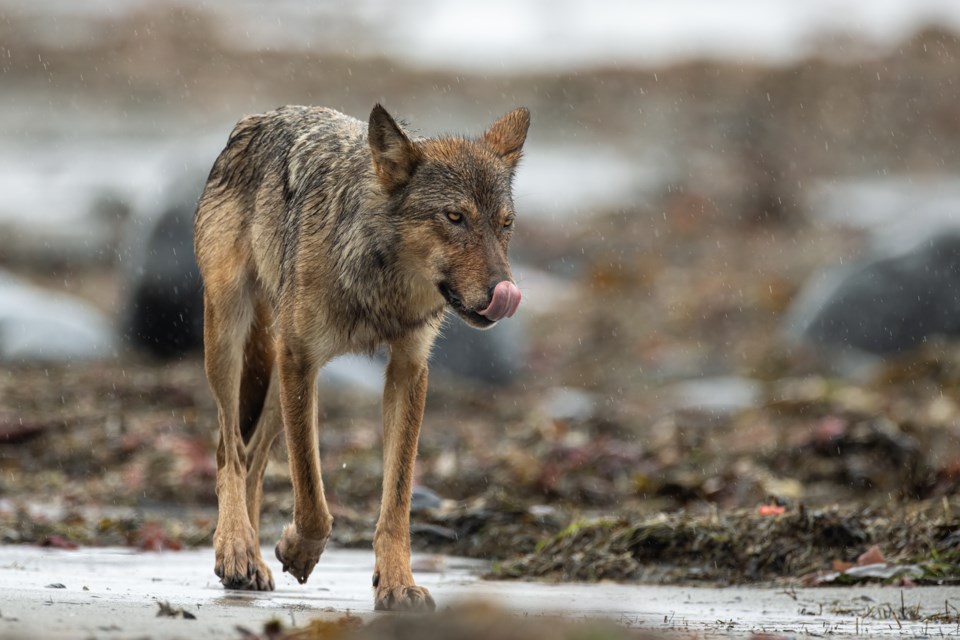While a coastal wolf swimming in the waters is a beautiful sight to behold, people need to give the animals plenty of space, warn animal experts.
On March 26, Maxine Caroline Gillette was in a boat conducting environmental monitoring as part of a guardianship program when she spotted a wolf swimming near Kyuquot Sound off the coast of Vancouver Island. Keeping her distance, Gillette was able to film the wolf as it headed toward Union Island.
The video quickly gained traction online.
"This beautiful coastal wolf is doing exactly what coastal wolves tend to do. It was beautiful," said Chris Darimont, a professor at the University of Victoria who is also a scientist with the Raincoast Conservation Foundation.
Gillette did all the right things when filming the animal, which was vulnerable while swimming, says Darimont, including ensuring she kept a respectful distance for a short period.
"It would be (a) contravention of the Wildlife Act to approach and harass (it)," said Darimont.
According to local wildlife guide Tom McPherson, others were not so respectful. McPherson notes he was recently alerted to "disappointing" social media videos where people cut directly in front of the wolf.
"Wolves are nervous when they swim because they are vulnerable," said McPherson. "We just need to give these animals their space to do their thing — and it's always gonna involve getting to a food source or covering some territory that requires swimming to access.
"It's a really important part of what they do, and swimming in the ocean is essentially one of the things that make them sea wolves."
How much space do you need to give?
Seeing a wolf swimming is a rare experience and can understandably be exciting, but McPherson notes you should remain at a distance. As a rule of thumb, you should be far enough that your cellphone cannot capture the wolf.
"You should have very long lenses," said McPherson. "If you're filming a swimming wolf with an iPhone and you're getting great photos, you're definitely too close."
He hopes people will educate themselves on the sea wolves. He recommends people start with the Island of the Sea Wolves documentary on Netflix, which he conducted the guiding for.
"We had some pretty major cameras ... 1,000-millimetre lenses with extenders, so we were able to be quite a ways back and give her the space she needed," he notes of the wolf in the documentary.
Why are wolves swimming in the ocean?
With thousands of islands making up the west coast of Canada, the wolves need to move around to get to various locations for foraging.
Darimont's past research focused on understanding these wolves and "how what we think of as a terrestrial corner carnivore, in fact, makes much of its living from the ocean and uses the ocean as a way to get to little food patches."
He spent lots of time in a boat in the early morning and late in the day when wolves are active.
McPherson echos this, stating the wolves swim to find new food sources or patrol their island territories.
"They should be given the space to go about their business and not have to contend with humans cutting directly in front of them with a boat," said McPherson, adding that when an animal has to alter its behaviour because of a human, it is having an adverse impact on the creature.
How Coastal British Columbia wolves are distinct
The wolves who call Vancouver Island and coastal British Columbia home are among the most genetically and ecologically distinct wolves, according to Darimont.
"Morphologically, that is how they look. They tend to be a bit smaller. They tend to often have a little bit of red coloration on them," said Darimont. "They eat much of their food from the ocean if their home range is next to the ocean. They're really a very special wolf."
He hopes these spectacular and natural sightings will continue for future generations to enjoy.
"We need to keep old-growth forests, restore salmon populations, and take care of the marine environment. We shouldn't kill wolves for sport, which is currently the law right now," said Darimont. "If we do all these things, we'll be lucky enough to have these sorts of spectacular encounters well into the future."
Photographer Steve Woods has photographed animals all around the world but capturing the lives of the wolves on Vancouver Island’s coast had a lasting impact on him.
"To slowly be allowed into their world was truly a humbling experience,” said Woods. "These animals live on the edge of existence, surviving on the bounty that is washed up from the oceans, swimming between islands to carve out new territory and search for beached carrion."
His striking photography shows a glimpse into the animal's natural habitat.
“It always surprises me that these animals aren't celebrated and revered as much as they should be,” said Woods. "We often find the boundaries between the natural world and the human world an area that is brought with conflict, which is why we document them to visually show the world how incredible these animals are and how lucky we are to live alongside them."



